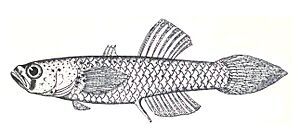Sinarapan facts for kids
Quick facts for kids Sinarapan |
|
|---|---|
 |
|
| Conservation status | |
| Scientific classification | |
| Synonyms | |
|
The Sinarapan (also called Tabyos) is a tiny fish found only in the Philippines. Its scientific name is Mistichthys luzonensis. It belongs to a group of fish called gobys.
This special fish is the only one in its genus, Mistichthys. It lives in freshwater lakes and rivers in the Bicol region of the Philippines. You can find it in the Bicol River and in lakes like Lake Buhi, Lake Bato, and Lakelets Katugday and Manapao. It also lives in Danao Lake in Polangui, Albay.
Contents
What is the Sinarapan?
The Sinarapan is one of the smallest fish in the world. It grows to be only about 2.5 centimeters long. That's about the size of your thumbnail!
This tiny fish is mostly clear, so you can almost see through it. It has a few dark spots on its body and bright black eyes.
Where Does it Live?
The Sinarapan is a freshwater fish. It lives in lakes, from the shallow edges all the way down to 12 meters deep. It likes to swim in groups, which is called schooling.
Why is the Sinarapan Special?
The Sinarapan, or Tabyos, is a very important fish to the people in the Philippines. It is considered a local food that tastes delicious. People often fry or boil it and serve it with vegetables.
This tiny fish even holds a world record! It is listed in the Guinness Book of Records as the "smallest commercially-harvested food fish." This means it's the tiniest fish that people catch and sell to eat.
How is it Caught?
Because Sinarapan fish swim in large groups, they are easier to catch. Fishermen use nets and even palm leaves to gather them. People have been catching and eating Sinarapan since the 1940s.
Helping the Sinarapan
By the 1990s, people noticed that the Sinarapan was in trouble. Too many were being caught, which is called overfishing. This made the fish almost disappear, putting it close to extinction.
Another problem was new types of fish being put into the lakes where Sinarapan lived. One of these was the Nile tilapia. These new fish competed with the Sinarapan for food and space.
Conservation Efforts
To help the Sinarapan survive, people started moving thousands of them to safer lakes. The goal was for them to reproduce and grow their numbers in these new homes.
Moving the fish was very hard because they are so delicate. More than half of the fish often died during the trip. But by 2001, there was good news! The Sinarapan started to reproduce successfully in their new habitats. This showed that the conservation efforts were working.


